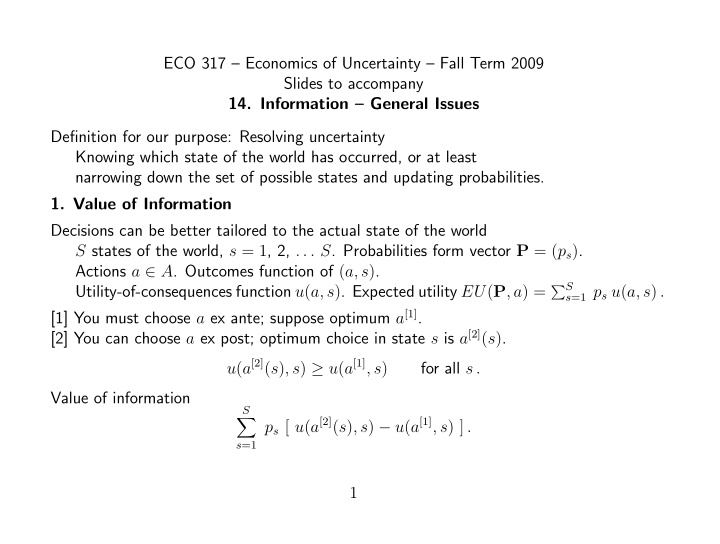



ECO 317 – Economics of Uncertainty – Fall Term 2009 Slides to accompany 14. Information – General Issues Definition for our purpose: Resolving uncertainty Knowing which state of the world has occurred, or at least narrowing down the set of possible states and updating probabilities. 1. Value of Information Decisions can be better tailored to the actual state of the world S states of the world, s = 1 , 2, . . . S . Probabilities form vector P = ( p s ) . Actions a ∈ A . Outcomes function of ( a, s ) . � S Utility-of-consequences function u ( a, s ) . Expected utility EU ( P , a ) = s =1 p s u ( a, s ) . [1] You must choose a ex ante; suppose optimum a [1] . [2] You can choose a ex post; optimum choice in state s is a [2] ( s ) . u ( a [2] ( s ) , s ) ≥ u ( a [1] , s ) for all s . Value of information S p s [ u ( a [2] ( s ) , s ) − u ( a [1] , s ) ] . � s =1 1
Value of Partial Information Items of interim information: m = 1 , 2, . . . M . The probability seeing m is q m . Conditional probability vectors for economically relevant states P m = ( p m s ) . So before you get the interim information, the probability of state s is M M q m P m . � q m p m � forming vector Q ≡ s m =1 m =1 [1] You must choose action a before geting interim information. Resulting expected utility V ( Q ) ≡ max a ∈ A EU ( Q , a ) . [2] You can make the decision after you get the interim information. When m is known, result V ( P m ) = max a m ∈ A EU ( P m , a m ) and the expected value of this ex ante is M � q m V ( P m ) . m =1 2
Which is bigger: To answer this, note that the V function defined here is exactly the utility function representing induced preferences (Lecture Note 10, p. 11). This function is convex. Therefore � M M � � q m P m � q m V ( P m ) . V ( Q ) = V ≤ m =1 m =1 Even partial information is valuable; value = difference. 2. Option Values Since better information enables attainment of higher utility, ability to postpone decision to wait for new information is valuable. This is an “option” – the right but not the obligation to do something. Capital investment I . In state s , gross profit R ( s ) , can be negative. Label the states so that R ( s ) is an increasing function. Continuum of states s , density function f ( s ) over support [ s min , s max ] . For non-trivial problem, R ( s min ) < I < R ( s max ) . [1] If you invest before knowing state, expected net profit � s max � s max R ( s ) f ( s ) ds − I = [ R ( s ) − I ] f ( s ) ds . s min s min 3
[2] If have an option to invest, i.e. postpone decision until actual s is revealed, You will invest if s > s ∗ and not invest if s < s ∗ , where R ( s ∗ ) = I . Looking ahead to this, your expected profit is � s max [ R ( s ) − I ] f ( s ) ds . s ∗ Value of the ability or option to postpone the decision is � s max � s max [ R ( s ) − I ] f ( s ) ds − [ R ( s ) − I ] f ( s ) ds s ∗ s min � s ∗ = [ R ( s ) − I ] f ( s ) ds − s min � s ∗ = [ I − R ( s ) ] f ( s ) ds > 0 since I > R ( s ) for s < s ∗ . s min Bernanke’s (QJE) bad news principle : the value of the ability to wait for better information before making an irreversible decision is governed by the distribution of the bad outcomes, where you would lose if you act. Why? These are the losses that the ability to wait helps you avoid. 4
3. Asymmetric Information: Terminology and Taxonomy Degrees of asymmetry of information in economic transactions: 1. Verifiable: Demonstrable to third parties outside the transaction. Contracts can be conditioned on this; enforceable in courts. 2. Observable: Symmetric between parties to the transaction. Cannot write court-enforceable contracts, but can have implicit contracts that the parties will adhere to in a repeated game relationship. 3. Private: Only one of the parties to the transaction observes this. Feasible transaction must be incentive-compatible for informed party. Types of private information: 1. Hidden action. Consequences: moral hazard, incentive payments. 2. Private knowledge of characteristics such as skill, riskiness, . . . Consequences: Adverse selection, signaling, screening. 3. Private knowledge of realization of state of the world. Consequences: Monitoring or auditing strategies. 5
Recommend
More recommend